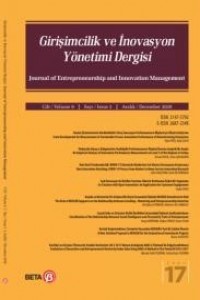Burak ÇAPRAZ, Nazlı Ayşe AYYILDIZ ÜNNÜ, Derya KELGOKMEN İLİC, Murat KOCAMAZ, Ural Gökay ÇİÇEKLİ, Burcu ARACIOĞLU, Aydın KOÇAK, Jülide KESKEN, Haluk SOYUER
Çalışanlar Perspektifinden İnovatif İş Davranışının Belirleyicileri: İzmir İlindeki Öncelikli Sektörlere İlişkin Bir Araştırma
Son yıllarda inovasyon kavramının başka alanlarda olduğu gibi iktisat ve işletme yazınlarında da önem kazanmaya başladığı görülmektedir. Bununla beraber, inovasyon kavramı sadece teknik ve iktisadi disiplinler açısından değerlendirilmemelidir. İşletme disiplini açısından yapılan inovasyon çalışmalarında inovatif iş davranışının önemli bir faktör olarak ele alındığı görülmektedir. Bu araştırmanın temel amacı, inovatif davranışın belirleyicilerinin ne olduğu ve aralarındaki temel ilişkinin ortaya konulmasıdır. Bu kapsamda inovatif iş davranışına ihtiyaç duyulduğu düşünülen ve İzmir Kalkınma Ajansı tarafından öncelikli sektörler olarak belirlenen beş sektörde yer alan firma çalışanları üzerinde yapılan alan çalışması sonucunda birey bazlı değişkenlerin inovatif iş davranışını daha fazla oluşturduğu belirlenmiştir. Kişinin içsel ilgisi, yenilikçilikten beklenen performans çıktıları, yenilikçilikten beklediği olumlu imaj, fikir üretmesi ve farkındalık çalışanları inovatif davranmaya yönlendirdiği belirlenmiştir
Innovative Work Behavior Determinants from the Perspective of Employees: A Research on Prior Industries in Izmir
In recent years it is seen that innovation concept is gaining more importance in economics and business literature as in specific fields. Nonetheless innovation concept should not be considered only from of technical and economics view. It is seen that innovative work behaviour is taken as an important factor for innovation in business studies. Research conducted on data collected from employees in five main industries which are defined as the prior industries by Izmir Regional Development Agency is tested where innovative work behaviour is more likely to be formed by individual-based variables. Intrinsic interest of individuals, expected performance outcomes from novelty, generating ideas and identifying opportunities are found to direct employees to act innovative.
Keywords:
-[PDF],
___
- Ahmad K. (2009): Management Development: Its Influence On Innovative Beha- viour and the Moderating Role of Proactivity, A Thesis Submitted in Fulfillment Of The Requirements For The Master Degree in Educational Science And Technology, Specialisation in Human Resource Development, Faculty Of Behavioural Sciences, University Of Twente The Netherlands.
- Amabile, T. (1988): “A Model Of Creativity and Innovation in Organizations”, In B. M. Staw & L. L. Cummings (Eds.), Research in Organizational Behavior, Vol: 10, pp. 123 – 167, Greenwich, CT: JAI Press.
- Amabile, T. M. (1996): Creativity in Context: Update to “The Social Psychology of Creativity.” Boulder, CO: Westview Press.
- Byrne, D. (1971): The Attraction Paradigm, New York: Academic Press.
- De Jong Jeroen J.(2004): “How Can Leaders Trigger Bottom-Up Innovation?, An Empirical Research İnto Knowledge Intensive Services”, Research Report, Zoeterme- er, SCALES-Scientific Analysis of Entrepreneurship and SMEs.
- De Jong J.P.J.(2007): Individual Innovation, The Connection Between Leadership and Employees’ Innovative Work Behavior, Academısch Proefschrıft, ISBN 978-90- 371-0725-8
- De Jong J.P.J. and Den Hartog, D.N. (2010): “Measuring Innovative Work Behavi- ourcaim”, Vol: 19, No: 1, pp. 23 – 36.
- De Jong, J.P.J., and Den Hartog, D. (2007): “How Leaders Influence Employees’ In- novative Behaviour”, European Journal of Innovation Management, 10(1), pp.41-64.
- De Jong, J.P.J. and Vermeulen, P.A.M. (2005): “Innovatie in Onderzoek en Onder- wijs: wat Leren Onze Studenten? (Innovation in Research And Education: What Do Our Students Learn?)”, Tijdschrift voor Hoger Onderwijs, Vol: 43, No: 1, pp. 17 – 43.
- Dorenbosch L., Van Engen M. L. and Verhagen M. (2005): “On-the-job Innovati- on: The Impact of Job Design and Human Resource Management through Production Ownership”, Creativity And Innovation Management, Vol: 14, No: 2.
- Drucker, P.F. (1985): Innovation and Entrepreneurship: Practice and Principles. Harper and Row, New York.
- Ramamoorthy, N., Flood, P. C., Slattery, T., and Sardessai, R. (2005): “Determi- nants of Innovative Work Behaviour: Development and Test of an Integrated Model”, Creativity & Innovation Management, 14(2), pp.142-150.
- Reuvers, M., Van Engen, M.L., Vinkenburg, C.J. and Wilson-Evered, E. (2008): “Transformational Leadership And Innovative Work Behaviour: Exploring The Rele- vance Of Gender Differences”, Creativity And Innovation Management, Vol: 17, No: 3, pp. 227–244
- Rummel, R.J. (1988): Applied Factor Analysis, Northwestern University Press, USA.
- Schlenker, B. R. (1980): Impression Management: The Self-Concept, Social Identity, And Interpersonal Relations. Monterey, CA: Brooks/Cole.
- Schumpeter, J.A. (1934): Theory of Economic Development, Cambridge: Har- vard University Press.
- Scott, S. G. and Bruce, R. A. (1994): “Determinants Of Innovative Behavior: A Path Model of Individual Innovation in the Workplace”, Academy of Management Journal, Vol: 37, pp. 580 – 607.
- Sutton, R.I., and Hargadon, A. (1996): “Brainstorming Groups in Context: Effec- tiveness in a Product Design Firm”, Administrative Science Quarterly, Vol: 41, pp. 685 – 718.
- Tsui, A.S., and O’Reilly, C.O. (1989): “Beyond Simple Demographic Effects: The Importance of Relational Demography in Superior-Subordinate Dyads”, Academy of Management Journal, 32, pp.402-423.
- Van de Ven, A. (1986): “Central Problems in the Management of Innovation”, Management Science, Vol: 32, pp. 590 – 607.
- Varma, A., and Stroh, L. K. (2001): “The Impact Of Same-Sex LMX Dyads on Performance Evaluations”, Human Resource Management, 40(4), pp.309-320.
- West, M.A. (2002): “Sparkling Fountains or Stagnant Ponds: An Integrative Mo- del of Creativity and Innovation Implementation in Work Groups”, Applied Psycho- logy: An International Review, Vol: 51, pp. 355 – 387.
- Woodman, R. W., Sawyer, J. E., and Griffin, R. W. (1993): “Toward A Theory Of Organizational Creativity”, Academy of Management Review, Vol:18, pp. 293 – 321.
- Yuan, F. and Woodman, R.W. (2010): “ Innovative Behavıor in the Workplace: The Role of Performance and Image Outcome Expectations”, Academy of Manage- ment Journal, Vol: 53, No: 2, pp. 323 – 342.
- ISSN: 2147-5792
- Başlangıç: 2012
- Yayıncı: Beta Basım Yayım Dağıtım A.Ş.
Sayıdaki Diğer Makaleler
Bolanle OYEDOYIN, Mathew Olugbenga ILORI, Timothy OYEBISI, Billy Agbebola OLUWALE, Oluseye Oladayo JEGEDE
Yenilikçilik mi? Tüketim mi?: Yenilikçi Tüketime Eleştirel Bir Yaklaşım ve Nitel Bir Analiz
Özge GÖKBULUT ÖZDEMİR, Deniz ÖZER
A Short Review on SMEs, Innovation and Financial Markets
Selçuk KARAATA, Fatma HACIOĞLU
Burak ÇAPRAZ, Nazlı Ayşe AYYILDIZ ÜNNÜ, Derya KELGOKMEN İLİC, Murat KOCAMAZ, Ural Gökay ÇİÇEKLİ, Burcu ARACIOĞLU, Aydın KOÇAK, Jülide KESKEN, Haluk SOYUER
